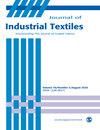聚酰胺6/碳纳米管/炭黑双组分熔体纺丝:熔体质量流率对电导率影响的研究
IF 2
4区 工程技术
Q1 MATERIALS SCIENCE, TEXTILES
引用次数: 0
摘要
将几种混合相结构和性能特征与导电、高纵横比的纳米填料(如碳纳米管、石墨烯和炭黑)相结合,可以在熔融纺丝中获得特定的形态结构,为开发新的功能纤维提供了更大的潜力。因此,了解和控制熔体纺丝过程中发展相形态中的填料定位是必要结构的关键。这项工作旨在提供从具有高填充浓度的导电聚合物复合材料中生产纤维的可能性。首先,研究了不同的市售纳米填料,如多壁碳纳米管(MWCNTs)、石墨烯和炭黑对聚酰胺6 (PA6)基纳米复合熔融纺丝纤维的影响。在实验室规模的熔融纺丝实验之后,选择含有10 wt%纳米填料(各5 wt%)的PA6/MWCNT-CB纳米复合长丝进行中试规模的双组分熔融纺丝工艺,研究纳米复合芯材进料参数对熔融纺丝纤维性能的影响。当熔体流动速率从3 g/min增加到6 g/min时,电导率下降了一半(从3.13E-02降至6.72E-03)。扫描电镜显微图和热重分析热图显示,MFR值的变化对纳米复合材料的表面性能有显著影响。本文章由计算机程序翻译,如有差异,请以英文原文为准。
Bicomponent melt spinning of polyamide 6/carbon nanotube/carbon black filaments: Investigation of effect of melt mass-flow rate on electrical conductivity
Combining the several mixed phase structures and property profiles with a conductive, high aspect ratios nanofiller such as carbon nanotubes, graphene, and carbon black, specific morphological structures in melt spinning can be reached that offer much more potential for developing new functional fibers. Thus, understanding and controlling filler localization inside the developing phase morphology during melt spinning are the keys to the necessary structures. This work aimed to offer the possibility of producing fibers from electrically conductive polymer composites with a high filler concentration. First, the influence of different commercially available nanofillers, such as multi-wall carbon nanotubes (MWCNTs), graphene and carbon black on Polyamide 6 (PA6)-based nanocomposite melt-spun fibers were examined. Following the lab-scale melt spinning experiments, PA6/MWCNT-CB nanocomposite filaments containing 10 wt% nanofiller (each 5 wt%), were chosen for a pilot-scale bicomponent melt spinning process to investigate the influence of the nanocomposite core material feeding parameters on the properties of melt-spun fibers. The electrical conductivity decreased by half (from 3.13E-02 to 6.72E-03) when melt flow rate was increased from 3 g/min to 6 g/min. Scanning electron microscopy micrographs and thermal gravimetric analysis thermograms showed that the change in MFR values significantly affected the nanocomposite filaments’ surface properties.
求助全文
通过发布文献求助,成功后即可免费获取论文全文。
去求助
来源期刊

Journal of Industrial Textiles
MATERIALS SCIENCE, TEXTILES-
CiteScore
5.30
自引率
18.80%
发文量
165
审稿时长
2.3 months
期刊介绍:
The Journal of Industrial Textiles is the only peer reviewed journal devoted exclusively to technology, processing, methodology, modelling and applications in technical textiles, nonwovens, coated and laminated fabrics, textile composites and nanofibers.
 求助内容:
求助内容: 应助结果提醒方式:
应助结果提醒方式:


